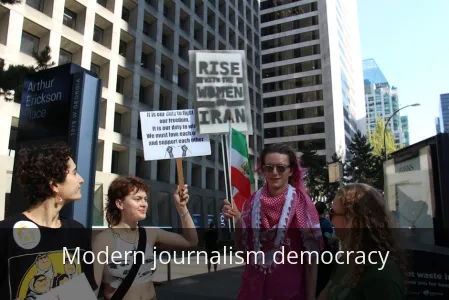
Imagine trying to navigate a complex, winding road in the dead of night with a fogged-up windshield and a map that’s actively lying to you.
This isn’t a nightmare; it’s the reality for citizens trying to participate in democracy today, and the institution we once trusted to clear the fog—journalism—is now often the one obscuring the glass.
The fourth estate, once hailed as a crucial pillar of a functioning society, is now quietly chipping away at democracy’s very foundation.
This isn’t about a grand conspiracy but a slow, insidious decay driven by perverse incentives and a catastrophic departure from core principles.
By the end of this article, you’ll understand the three critical failures turning modern journalism from a watchdog into a destructive force, and you’ll never consume your news the same way again.
From Information to Infotainment: The Dumbing Down of the Citizenry

Gone are the days when the evening news was a sober, fact-based recounting of the day’s most important events.
In its place, we have a 24/7 circus of infotainment, where the value of a story is measured not by its civic importance but by its ability to generate clicks, clips, and viral moments.
Why dedicate precious airtime to a nuanced analysis of a new housing policy when a heated, on-air shouting match about a celebrity scandal will guarantee higher ratings?
This shift has a devastating impact: it creates a population that is entertained, perhaps even outraged, but critically uninformed about the issues that actually govern their lives.
We know more about the personal lives of politicians than their policy positions.
Complex geopolitical conflicts are reduced to sensational, decontextualized three-minute segments, stripping away all history and nuance.
The result is a citizenry armed with talking points instead of knowledge, ready to argue but utterly unprepared to understand, let alone solve, the monumental challenges we face.
Algorithmic Echo Chambers: The Engagement Trap That Divides Us

If infotainment dumbs us down, the digital architecture of modern news radicalizes us.
Social media platforms and their algorithmic feeds are not neutral town squares; they are engagement-maximizing machines with a voracious appetite for outrage.
These algorithms have learned, with terrifying efficiency, that nothing keeps users glued to a screen like fear, anger, and moral indignation.
Consequently, the most extreme, divisive, and often misleading content is prioritized and amplified, seamlessly delivered into personalized echo chambers.
You’re served a diet of information that confirms your biases and vilifies the “other side,” creating a distorted view of reality where your political opponents are not just people you disagree with, but existential threats.
This isn’t an accident; it’s a business model.
Outrage drives clicks, clicks drive ad revenue, and the cycle continues, fracturing our shared sense of reality and making civil discourse or political compromise seem impossible.
The goal is no longer to inform the public but to capture its fractured attention, profitably.
The Trust Apocalypse: How “Both-Sidesism” Gives Misinformation a Megaphone

The most dangerous failure of modern journalism might be its role in manufacturing this very distrust.
In a misguided attempt to appear “balanced” and objective, major outlets often fall into the trap of false equivalence, or both-sidesism.
This is the practice of presenting two sides of an issue as equally valid when the factual evidence overwhelmingly supports one.
Imagine a headline that reads “Scientists and Flat Earthers Debate Shape of the Planet,” giving a platform to blatant nonsense under the guise of fairness.
This happens constantly with climate change, vaccine efficacy, and election integrity.
By failing to consistently and courageously label misinformation and lies for what they are, journalism lends them a credibility they do not deserve.
This creates a world where citizens, bombarded with conflicting claims from seemingly equal sources, throw up their hands and decide to trust nothing and no one.
When everything is presented as a matter of opinion, nothing is a matter of fact.
The erosion of trust isn’t just a side effect; it’s the poison that kills democracy, which cannot function without a common basis of truth.
So, where does this path lead us?
The silent killing is well underway, manifesting as paralyzing polarization, widespread apathy, and a growing flirtation with authoritarianism by a public desperate for simple answers to complex problems.
A democracy without a shared reality, a informed citizenry, or trusted institutions is not a democracy at all; it’s just a crowd of angry, confused people, easily manipulated and led.
The warning is stark: if we continue to consume news that prioritizes entertainment over information, outrage over understanding, and false balance over truth, we are not just watching the decline of journalism—we are actively participating in the unraveling of our own democratic experiment.
The question is, what will you do about it?
My Small Act of Defiance: Reclaiming My News Feed

So, what’s one to do when the news cycle feels like a raging firehose of chaos?
For me, the answer wasn’t to tune out, but to tune in more intentionally.
I made a choice that felt like a small act of defiance: I invested in a Digital News Subscription.
Specifically, I chose the Washington Post Digital Subscription, and it fundamentally changed my relationship with the news.
Gone are the days of being served stories designed to outrage me by a mysterious algorithm.
Instead, I now actively seek out vetted, in-depth reporting from journalists whose only KPI is the truth.
It’s the difference between eating from a carefully prepared meal and scavenging from a dumpster.
This simple shift means I’m not just a passive consumer; I’m an active participant in supporting a system that prioritizes integrity over engagement.
I’m not just reading the news—I’m helping to fund its survival.
And honestly, that feels pretty powerful.

Leave a Reply